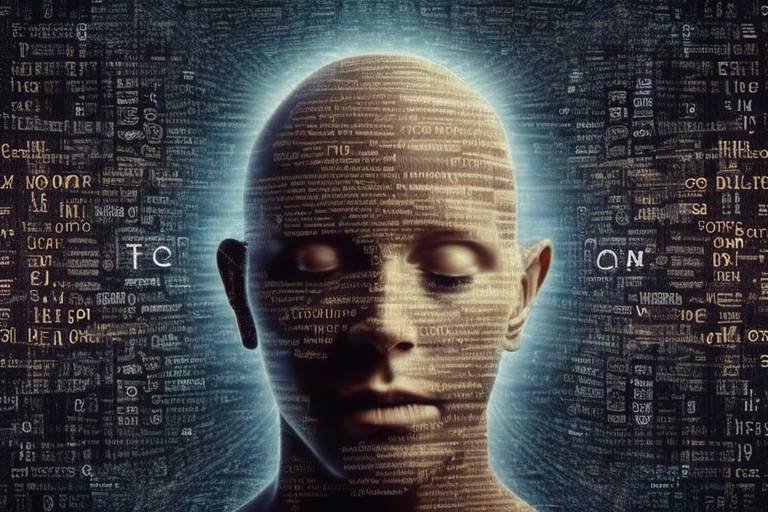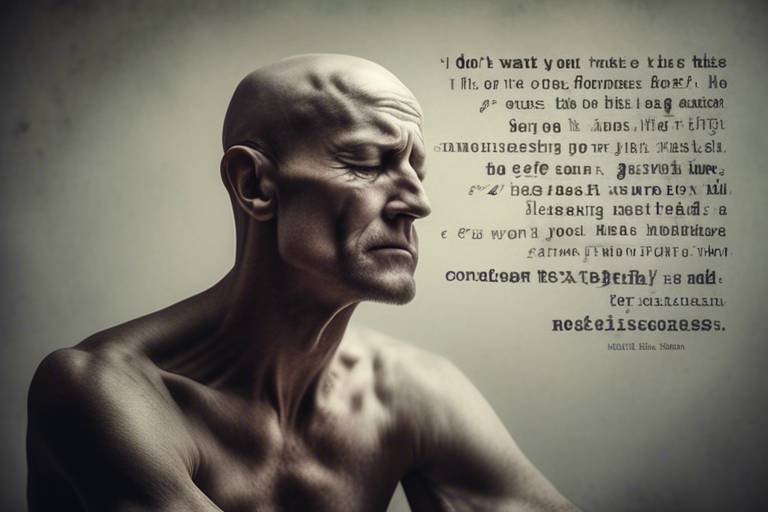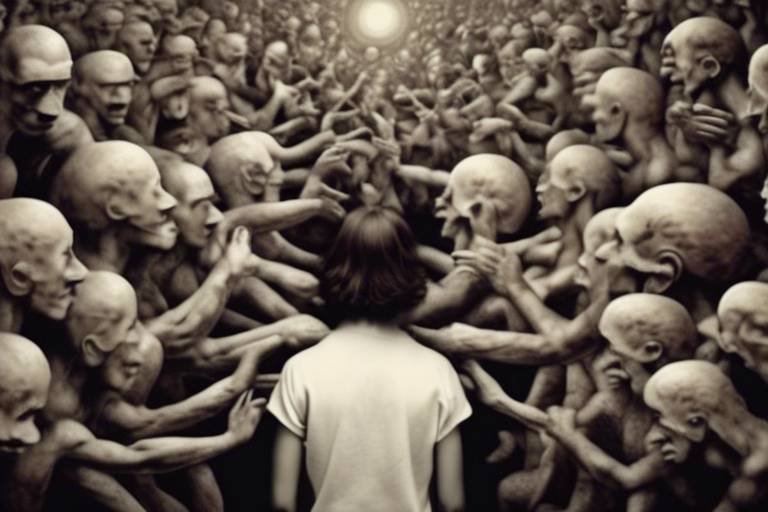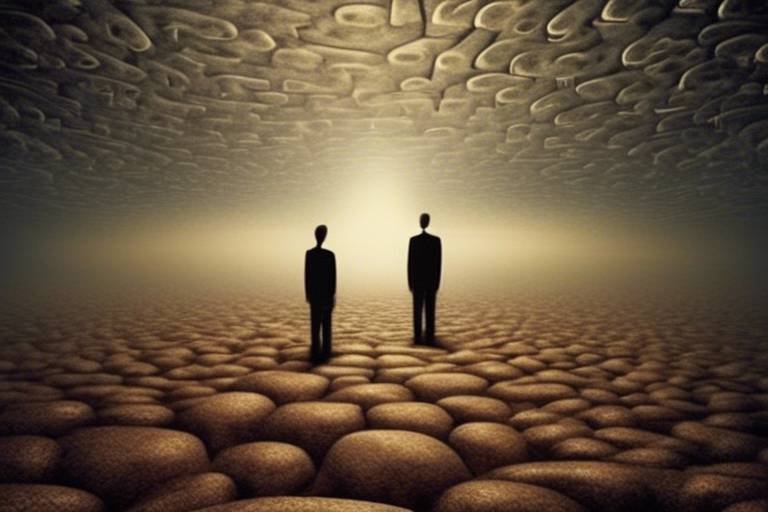The Link Between Human Brain and Consciousness
The relationship between the human brain and consciousness is a captivating subject that has intrigued scientists, philosophers, and curious minds alike for centuries. What is consciousness, and how does it arise from the intricate web of neurons firing in our brains? These questions might seem straightforward, but they plunge us into a profound exploration of our very existence. Imagine consciousness as a vast ocean, where the brain is the shoreline; while the waves (thoughts and experiences) crash against the land, they are shaped and influenced by the contours of the shore. Understanding this link not only helps us grasp the essence of being human but also sheds light on our identity and experiences.
At its core, consciousness is often defined as the state of being aware of and able to think about one’s own existence, thoughts, and surroundings. Yet, this definition barely scratches the surface of a much deeper and more complex phenomenon. The discussions surrounding consciousness are often filled with philosophical debates, scientific inquiries, and even spiritual interpretations. Some argue that consciousness is a byproduct of brain activity, while others suggest it exists independently of the physical brain. This divergence in thought leads us to ponder: is consciousness merely a function of neural processes, or is there something more profound at play?
As we delve deeper into understanding this enigmatic relationship, we find ourselves navigating through various theories and research findings. Scientists have been employing advanced methods to probe the inner workings of the brain, aiming to uncover the neural correlates of consciousness. For instance, studies utilizing functional MRI (fMRI) technology have unveiled specific brain regions that light up during conscious thought, suggesting a fascinating interplay between brain activity and conscious experience. The more we learn, the more we realize that consciousness is not a singular entity but rather a tapestry woven from various threads of neural activity, perception, and awareness.
In this exploration, it’s essential to acknowledge that altered states of consciousness, such as those experienced during sleep, meditation, or under the influence of psychoactive substances, provide unique insights into how our brains function. These states challenge conventional notions of consciousness and reveal the brain's remarkable adaptability and complexity. For example, during meditation, practitioners often report heightened awareness and clarity of thought, which correlates with specific changes in brain activity. This phenomenon raises intriguing questions about the potential for enhancing consciousness through deliberate practices.
Ultimately, the link between the human brain and consciousness is a multifaceted puzzle. While we may not yet have all the pieces, each study, each theory, and each personal experience brings us closer to understanding the essence of what it means to be conscious. As we continue this journey of discovery, we invite you to ponder your own experiences of consciousness and how they shape your identity and understanding of the world around you.
- What is consciousness? Consciousness refers to the state of being aware of and able to think about one’s own existence, thoughts, and surroundings.
- How does the brain contribute to consciousness? Different regions of the brain are activated during conscious thought, suggesting that consciousness arises from complex neural processes.
- What are altered states of consciousness? Altered states of consciousness include experiences such as sleep, meditation, and drug-induced states that can change our perceptions and awareness.
- Can meditation affect consciousness? Yes, research shows that meditation can alter brain activity and enhance awareness, leading to different states of consciousness.
- What role do psychoactive substances play in understanding consciousness? Psychoactive substances can significantly alter consciousness and provide insights into the nature of conscious experience by affecting brain function.

The Nature of Consciousness
Consciousness is often described as the final frontier of human experience, a complex tapestry woven from thoughts, feelings, and perceptions. It remains one of the most profound mysteries that challenges our understanding of the mind and self. But what exactly is consciousness? Is it merely the sum of our experiences, or is there something deeper at play? The debates surrounding consciousness are vast and varied, encompassing fields such as philosophy, neuroscience, and psychology.
At its core, consciousness can be viewed as our awareness of ourselves and the world around us. It allows us to engage with our environment, make decisions, and reflect on our existence. However, defining consciousness is no easy task. Some scholars argue that it is a continuous stream of experiences, while others suggest it consists of discrete moments of awareness. This leads us to a crucial question: can consciousness be measured or quantified? The answer is still up for debate.
Philosophically, consciousness has been dissected into various components. The phenomenal aspect refers to the subjective experience of being aware—what it feels like to see a sunset or taste chocolate. On the other hand, the access aspect pertains to the information we can report and utilize in our cognitive processes. These distinctions illustrate the complexity of consciousness and why it eludes a singular definition.
Furthermore, the relationship between consciousness and the brain is a hot topic in contemporary research. While some argue that consciousness arises from specific neural activities, others propose that it is a fundamental aspect of reality, akin to space and time. This divergence in perspectives raises intriguing questions about the nature of reality itself. Are we merely biological machines, or is there a deeper essence to our being?
To understand consciousness better, researchers have explored various models and theories. For instance, the Integrated Information Theory posits that consciousness corresponds to the level of information integration within a system. Alternatively, the Global Workspace Theory suggests that consciousness is like a theater spotlight, illuminating certain thoughts while others remain in the dark. Each theory provides a different lens through which we can examine the intricate relationship between the brain and conscious experience.
As we delve deeper into the nature of consciousness, we encounter altered states that challenge conventional understandings. States such as dreaming, meditation, and even the effects of psychedelic substances provide unique insights into the workings of the mind. These experiences can shift our perception of reality, prompting us to reconsider what it means to be conscious.
In summary, consciousness is a multifaceted phenomenon that intertwines with our identity and existence. It raises profound questions about the essence of being human and the nature of reality itself. As science continues to unravel the mysteries of the brain, we may edge closer to understanding this elusive aspect of our lives.
- What is consciousness? Consciousness refers to our awareness of ourselves and our surroundings, encompassing thoughts, feelings, and perceptions.
- Can consciousness be measured? The measurement of consciousness is a topic of debate, with various theories attempting to quantify it through neural activity and information processing.
- How does altered states of consciousness affect our understanding? Altered states, such as dreaming or meditation, challenge our conventional views on consciousness and provide insights into the nature of reality.

The Brain's Role in Consciousness
The relationship between the brain and consciousness is a complex tapestry woven from various strands of neuroscience, psychology, and philosophy. At its core, consciousness can be seen as our awareness of ourselves and our environment, but what exactly happens in the brain to give rise to this experience? To unravel this mystery, researchers have dedicated countless hours to studying how different regions of the brain contribute to our conscious experience. The brain is not a monolithic entity; rather, it's a collection of specialized areas, each playing a unique role in the orchestra of consciousness.
One of the most fascinating aspects of this relationship is the concept of neural correlates of consciousness (NCC). These are specific brain states or processes that correspond to conscious experiences. For instance, when we perceive a vivid red apple, certain neurons in our visual cortex fire in a particular pattern, signaling our brain's interpretation of that stimulus. This intricate dance of neurons provides insight into how our brain constructs our conscious reality. Researchers have identified several key brain regions that are particularly vital for consciousness:
- The Thalamus: Often referred to as the "gateway to consciousness," the thalamus processes sensory information and relays it to the appropriate areas of the cortex, playing a crucial role in our awareness of the environment.
- The Cerebral Cortex: This outer layer of the brain is involved in higher-order functions such as thought, perception, and decision-making. Different areas of the cortex are activated during various conscious tasks.
- The Brainstem: This area regulates basic life functions and is essential for maintaining wakefulness and alertness, serving as a foundation for conscious experience.
Understanding how these regions work together is pivotal in unraveling the enigma of consciousness. For instance, studies have shown that damage to the thalamus can lead to profound alterations in consciousness, such as in cases of coma or vegetative states. Conversely, when the cerebral cortex is stimulated, it can evoke vivid conscious experiences, even in individuals who are otherwise unresponsive. This interplay highlights the brain's role as a dynamic system, where different regions communicate and collaborate to create the rich tapestry of conscious experience.
Moreover, the mechanisms underlying consciousness extend beyond mere localization of function. The brain operates through intricate networks, where the interaction between different regions can lead to emergent properties of consciousness. For example, the default mode network—a network of brain regions that are active when we are at rest and not focused on the external environment—has been linked to self-referential thought and daydreaming. This suggests that consciousness is not only a product of isolated brain areas but is also about how these areas connect and communicate with one another.
As we delve deeper into the study of consciousness, we encounter a fascinating array of methodologies that neuroscientists employ. Techniques like functional MRI (fMRI) and electroencephalography (EEG) allow researchers to visualize and measure brain activity in real-time. These tools have opened up new avenues for understanding how consciousness arises from brain activity, providing a window into the neural underpinnings of our subjective experiences.
In summary, the brain's role in consciousness is a multifaceted and evolving field of study. It involves not only identifying specific regions associated with conscious thought but also understanding the complex interactions between these areas. As research continues, we may uncover even more about how our brains create the rich, vivid experiences that define our conscious lives.
- What is consciousness? Consciousness refers to the awareness of one's own existence, thoughts, and surroundings.
- Which parts of the brain are involved in consciousness? Key areas include the thalamus, cerebral cortex, and brainstem.
- How do scientists study consciousness? Researchers use tools like fMRI and EEG to observe brain activity and its relationship to conscious experiences.
- What are neural correlates of consciousness? These are specific brain states or processes that correspond to conscious experiences.

The exploration of consciousness is not just a philosophical endeavor; it is deeply rooted in neuroscience. Neuroscientific approaches employ a variety of methodologies to delve into the intricate workings of the brain and its relationship with conscious experience. These methods are akin to a toolbox, each providing unique insights that help us piece together the puzzle of consciousness. Imagine trying to assemble a complex jigsaw puzzle without knowing what the final picture looks like—this is similar to the challenge researchers face when studying consciousness.
One of the most prominent techniques used in neuroscience is brain imaging, which allows scientists to visualize the brain in action. Methods such as functional magnetic resonance imaging (fMRI) and positron emission tomography (PET) have been pivotal in identifying brain regions that are activated during specific conscious experiences. For instance, fMRI has revealed that when individuals engage in conscious thought or decision-making, distinct areas of the prefrontal cortex light up, suggesting a direct link between these brain regions and our conscious awareness.
Another crucial tool is the electrophysiological method, which includes techniques like electroencephalograms (EEGs). EEGs measure the electrical activity of the brain through electrodes placed on the scalp, providing real-time data about brain wave patterns. This method is particularly insightful for understanding how different states of consciousness—such as sleep or meditation—manifest in brain activity. For example, during deep sleep, the brain exhibits slow delta waves, while during active thinking, faster beta waves dominate. This dynamic range of brain activity offers a fascinating glimpse into how our consciousness fluctuates throughout the day.
In addition to these methods, transcranial magnetic stimulation (TMS) has emerged as a groundbreaking approach. TMS uses magnetic fields to stimulate specific areas of the brain, allowing researchers to observe changes in consciousness and cognitive functions. By temporarily disrupting activity in targeted regions, scientists can infer the role these areas play in conscious experience. For instance, studies using TMS have demonstrated that stimulating the parietal lobe can alter our sense of self-awareness, shedding light on the neural correlates of consciousness.
As we continue to refine these techniques, the relationship between brain activity and consciousness becomes clearer. The findings from these neuroscientific approaches not only enhance our understanding of consciousness but also raise profound questions about the nature of human identity. If our conscious experiences can be altered by manipulating brain activity, what does that say about the essence of who we are? This intersection of neuroscience and philosophy invites us to reconsider our understanding of consciousness in a broader context.
In summary, neuroscientific approaches are essential for unraveling the complexities of consciousness. By employing a combination of brain imaging, electrophysiological methods, and stimulation techniques, researchers are making significant strides toward understanding how the brain gives rise to our conscious experiences. As we continue to explore these methodologies, we inch closer to answering some of the most profound questions about human existence.
- What is consciousness? Consciousness refers to the state of being aware of and able to think about one's own existence, thoughts, and surroundings.
- How does neuroscience study consciousness? Neuroscience studies consciousness through various methods, including brain imaging, electrophysiology, and stimulation techniques.
- What role does the brain play in consciousness? Different regions of the brain contribute to various aspects of conscious experience, influencing our awareness and perception.
- Can consciousness be altered? Yes, consciousness can be altered through various means, including sleep, meditation, and the use of psychoactive substances.

Functional Magnetic Resonance Imaging (fMRI) has emerged as a groundbreaking tool in neuroscience, offering a window into the intricate workings of the human brain. By measuring changes in blood flow, fMRI allows researchers to observe which areas of the brain are active during various tasks and states of consciousness. This non-invasive technique has provided invaluable insights into how conscious thought processes are linked to specific brain regions. Imagine being able to see the brain light up like a city at night, with different areas glowing in response to different stimuli or activities!
One of the most fascinating aspects of fMRI studies is how they have helped identify the neural correlates of consciousness. These studies have revealed that certain brain areas, such as the prefrontal cortex and the parietal lobe, play crucial roles in our conscious experience. For instance, when individuals engage in tasks that require decision-making or self-reflection, these regions show heightened activity. This leads to the intriguing question: What happens in the brain when we simply "think" without any external stimuli?
Research has demonstrated that fMRI can differentiate between various states of consciousness, such as wakefulness, sleep, and altered states induced by meditation or anesthesia. In one notable study, participants were asked to focus on specific thoughts while their brain activity was monitored. The results illustrated that even when participants were not actively engaged in a task, their brains were still buzzing with activity, suggesting that consciousness is not merely a byproduct of external stimuli but is deeply rooted in our brain's internal processes.
Moreover, fMRI studies have paved the way for new therapeutic approaches. For example, understanding how the brain responds to different forms of therapy can help tailor treatments for individuals suffering from mental health issues. By observing which regions are activated in response to therapeutic interventions, researchers can develop more effective strategies for enhancing consciousness and overall well-being.
In summary, fMRI studies have revolutionized our understanding of the relationship between brain activity and consciousness. They reveal a dynamic interplay between various brain regions and cognitive processes, challenging our traditional notions of how we experience awareness. As we continue to explore this fascinating field, the potential for new discoveries about the human mind seems limitless, promising to unlock even more secrets about who we are and how we perceive the world around us.
- What is fMRI? - Functional Magnetic Resonance Imaging is a technique that measures brain activity by detecting changes in blood flow.
- How does fMRI help in understanding consciousness? - It allows researchers to see which areas of the brain are active during different states of consciousness.
- Are there any risks associated with fMRI? - fMRI is considered safe as it does not involve radiation, but individuals with certain implants or devices may need to avoid it.
- Can fMRI be used for therapeutic purposes? - Yes, it can help tailor treatments by observing brain responses to various therapies.

Electroencephalograms, commonly known as EEGs, are powerful tools that allow researchers to peek into the electrical activity of the brain. Imagine trying to read a book in a dimly lit room; the EEG acts like a flashlight, illuminating the complex patterns of brain waves that correspond to various states of consciousness. By placing electrodes on the scalp, scientists can capture real-time data on how our brains function during different activities, such as sleeping, meditating, or even when we’re simply daydreaming.
EEGs measure the brain's electrical impulses, which are generated by the activity of neurons. These impulses are categorized into different wave types, each associated with specific mental states. For instance, delta waves are prevalent during deep sleep, while beta waves dominate during alert, active thinking. Understanding these patterns not only helps in diagnosing conditions like epilepsy but also sheds light on the intricate relationship between brain activity and consciousness.
One of the most fascinating aspects of EEG research is its ability to show how brain wave patterns change in response to various stimuli. For example, when a person is engaged in meditation, studies have shown a marked increase in alpha waves, which are linked to relaxation and a heightened state of awareness. This suggests that meditation can significantly alter our conscious experience, providing insights into how we can harness our minds for greater clarity and focus.
Furthermore, EEGs have revealed intriguing insights into the effects of psychoactive substances on consciousness. When individuals consume drugs, the brain's electrical activity can shift dramatically. For instance, the consumption of psychedelics has been associated with a unique pattern of brain waves that differs from both normal waking states and sleep. This change can lead to profound alterations in perception, thought processes, and emotional responses, providing a window into the vast possibilities of human consciousness.
In summary, EEGs offer a unique lens through which we can explore the depths of consciousness. By analyzing brain wave patterns, researchers can better understand the neural correlates of different states of awareness, paving the way for advancements in both neuroscience and psychology. As we continue to uncover the mysteries of the brain, EEG insights will undoubtedly play a pivotal role in our quest to understand the essence of what it means to be conscious.
- What is an EEG? An EEG, or electroencephalogram, is a test that detects electrical activity in the brain using small, flat metal discs called electrodes.
- How does an EEG work? Electrodes are placed on the scalp to measure electrical impulses that result from the activity of neurons. The data is then recorded and analyzed.
- What can an EEG diagnose? EEGs are commonly used to diagnose conditions such as epilepsy, sleep disorders, and other brain-related issues.
- Can an EEG show consciousness? While an EEG cannot directly measure consciousness, it can provide insights into the brain activity associated with different states of consciousness.

When we dive into the theories of consciousness, we find ourselves navigating a complex landscape filled with intriguing ideas and challenging questions. What exactly is consciousness? Is it merely a byproduct of brain activity, or does it represent something deeper? Various theories have emerged over the years, each offering unique insights into this multifaceted phenomenon. Among the most prominent theories are the Integrated Information Theory (IIT) and the Global Workspace Theory (GWT), both of which attempt to unravel the enigma of consciousness.
Integrated Information Theory suggests that consciousness corresponds to the level of information integration within a system. In simpler terms, the more interconnected and integrated the information within the brain, the richer the conscious experience. Think of it like a symphony orchestra; if all the instruments are playing in harmony, the resulting music is rich and full. However, if the instruments are out of sync, the music becomes chaotic and disjointed. This theory posits that our conscious experience is akin to that beautiful symphony, where every note and harmony contributes to the overall experience of being aware.
On the other hand, Global Workspace Theory presents a different angle. It posits that consciousness arises when information is broadcasted to various cognitive systems in the brain, much like a spotlight illuminating a stage. Only the information that is 'in the spotlight' becomes conscious, while the rest remains in the shadows, operating subconsciously. This theory emphasizes the importance of attention and awareness, suggesting that what we consciously experience is just a fraction of all the information our brain processes at any given moment.
Both theories have their strengths and limitations, and researchers continue to debate which, if any, provides a comprehensive explanation of consciousness. The implications of these theories stretch far beyond academic discussions; they touch upon our understanding of human identity and experience. For example, consider the implications of IIT in terms of artificial intelligence. If a machine can integrate information in a way similar to humans, could it also possess consciousness? Such questions spark lively debates among scientists, philosophers, and ethicists alike.
Moreover, the exploration of consciousness is not limited to theoretical frameworks. Empirical research continues to shed light on how these theories play out in real-world scenarios. For instance, advancements in neuroimaging techniques have allowed scientists to observe brain activity in real-time, providing valuable data that supports or challenges existing theories. Studies have shown that different brain regions activate in response to various stimuli, aligning with the predictions made by both IIT and GWT.
In summary, the theories of consciousness offer a fascinating glimpse into the workings of the human mind. They challenge us to reconsider our definitions of awareness and identity, pushing the boundaries of what we know about ourselves. As we continue to explore this uncharted territory, one thing is clear: consciousness is not just a scientific puzzle; it is a profound aspect of our existence that shapes our reality.
- What is consciousness? Consciousness refers to the state of being aware of and able to think about one’s own existence, thoughts, and surroundings.
- How do scientists study consciousness? Scientists use various methodologies, including neuroimaging techniques like fMRI and EEG, to study brain activity associated with conscious experiences.
- What are the main theories of consciousness? The two prominent theories are Integrated Information Theory (IIT) and Global Workspace Theory (GWT), each offering different perspectives on how consciousness arises.
- Can machines be conscious? This is a hotly debated topic. If machines can integrate information similarly to humans, some argue they might possess a form of consciousness.

Altered states of consciousness are fascinating phenomena that challenge our conventional understanding of the human mind. These states, which can be induced by various means such as sleep, meditation, or psychoactive substances, provide a unique window into the complexities of consciousness itself. Imagine your mind as a radio—under normal circumstances, it tunes into a specific frequency, allowing you to experience reality as you know it. But what happens when you change that frequency? You may encounter entirely different worlds of thought, perception, and awareness. This exploration is not just a scientific inquiry; it’s a journey into the very essence of what it means to be conscious.
One of the most intriguing aspects of altered states is how they can expand or contract our perception of reality. For instance, during deep sleep, our conscious awareness is significantly diminished, yet our brains remain active, processing information and consolidating memories. Conversely, in states of meditation, individuals often report heightened awareness and clarity of thought, leading to profound insights about themselves and their surroundings. This duality raises essential questions: What does it mean to be truly aware? Can we access deeper layers of consciousness through intentional practices?
Moreover, the impact of psychoactive substances on consciousness adds another layer of complexity. These substances can dramatically alter our sensory perceptions, emotions, and thought processes, sometimes leading to experiences that feel profoundly real. For example, consider the way psychedelics can dissolve the boundaries of self, allowing individuals to feel interconnected with the universe. This phenomenon has led researchers to explore the therapeutic potential of such substances in treating mental health disorders, highlighting the importance of understanding how they interact with our brain's chemistry.
To better understand these altered states, researchers often categorize them based on their characteristics and the methods of induction. Below is a table summarizing some common altered states and their defining features:
| Altered State | Method of Induction | Characteristics |
|---|---|---|
| Sleep | Natural biological processes | Reduced awareness, dreaming, memory consolidation |
| Meditation | Mindfulness practices | Heightened awareness, relaxation, altered perception of time |
| Hypnosis | Guided suggestion | Focused attention, increased suggestibility |
| Psychoactive Substances | Chemical ingestion | Altered perceptions, emotional shifts, dissociation |
As we delve deeper into these altered states, it becomes clear that they not only provide insight into the workings of the brain but also challenge our understanding of consciousness itself. Are these states merely deviations from our normal experience, or do they reveal fundamental truths about our existence? In exploring these questions, we not only enhance our understanding of consciousness but also gain valuable insights into the nature of human identity and experience.
- What are altered states of consciousness? Altered states of consciousness refer to any condition significantly different from normal waking consciousness, including sleep, meditation, and drug-induced states.
- How do altered states affect our perception? They can enhance or diminish perception, leading to experiences that may feel more profound or disconnected from reality.
- Are altered states of consciousness beneficial? Many people find benefits in practices like meditation, while some psychoactive substances are being researched for therapeutic uses.

Meditation has long been regarded as a gateway to deeper awareness and understanding of one’s own consciousness. It’s fascinating to think about how something as simple as sitting quietly and focusing on your breath can lead to profound changes in the brain. Research has shown that meditation can significantly alter brain activity, enhancing our ability to experience consciousness in new and enriching ways. This practice, often seen as a spiritual endeavor, is increasingly being embraced by scientists and psychologists alike for its potential to unlock the mysteries of the mind.
One of the most compelling aspects of meditation is its impact on brain structure and function. Studies using advanced imaging techniques, such as functional MRI (fMRI), have revealed that regular meditation can lead to increased gray matter density in areas of the brain associated with memory, emotional regulation, and self-awareness. For instance, the hippocampus, which plays a crucial role in memory formation, shows notable growth in those who meditate regularly. This suggests that meditation not only enhances our current state of consciousness but may also improve our cognitive functions over time.
Moreover, meditation practices can lead to a state of mindfulness, where individuals become more aware of their thoughts and feelings without judgment. This heightened state of awareness allows for a richer experience of consciousness, as practitioners learn to observe their mental processes rather than becoming entangled in them. Imagine your thoughts as clouds drifting across a vast sky; through meditation, you can learn to watch these clouds without being swept away by them. This shift in perspective can be transformative, leading to a greater sense of peace and clarity.
Interestingly, different types of meditation can induce various states of consciousness. For example, mindfulness meditation focuses on being present in the moment, while transcendental meditation often involves the repetition of a mantra, leading to a profound sense of relaxation and detachment from the ego. These practices can be categorized into two main types:
- Focused Attention Meditation: This involves concentrating on a single point of focus, such as the breath or a mantra.
- Open Monitoring Meditation: This encourages awareness of all thoughts and sensations without attachment or judgment.
Research has shown that both types can lead to significant changes in brainwave patterns. For instance, during meditation, practitioners often exhibit increased alpha waves, which are associated with relaxation and calmness, and decreased beta waves, which relate to active thinking and anxiety. This shift in brain activity not only enhances the meditation experience but also contributes to the overall well-being of the individual.
Furthermore, the long-term benefits of meditation extend beyond the practice itself. Many individuals report a lasting increase in their ability to manage stress, improve emotional health, and enhance overall cognitive functioning. These benefits underscore the idea that meditation is not merely a momentary escape from reality but a profound tool for understanding and enhancing consciousness.
In conclusion, the relationship between meditation and consciousness is both complex and enriching. As we continue to explore this fascinating connection, it becomes increasingly clear that meditation offers a unique lens through which to examine the nature of our conscious experience. By engaging in meditation, we not only cultivate a deeper understanding of ourselves but also unlock the potential for greater awareness and presence in our daily lives.
- What is meditation? Meditation is a practice that involves focusing the mind to achieve a state of calm and clarity.
- How does meditation affect the brain? Meditation can increase gray matter density and alter brainwave patterns, enhancing cognitive functions and emotional regulation.
- Can anyone meditate? Yes! Meditation is accessible to everyone and can be tailored to individual needs and preferences.
- How long should I meditate for? Even a few minutes a day can be beneficial, but many practitioners find that longer sessions yield greater benefits.

Psychoactive substances have a profound impact on the human brain and consciousness, opening a Pandora's box of experiences that can range from euphoric to terrifying. These substances, which include a variety of drugs like alcohol, cannabis, hallucinogens, and stimulants, interact with the brain's neurotransmitter systems, altering mood, perception, and cognition. But how exactly do they work? And what does this mean for our understanding of consciousness?
When we consume psychoactive substances, they can produce a wide array of effects by mimicking or blocking the brain's natural chemicals. For instance, substances like cannabis primarily affect the endocannabinoid system, leading to altered sensory perceptions and enhanced emotional responses. On the other hand, stimulants like cocaine and amphetamines increase dopamine levels, resulting in heightened alertness and energy but also potential addiction and negative consequences. This intricate dance between substances and brain chemistry raises fascinating questions about the nature of consciousness itself.
One of the most intriguing aspects of psychoactive substances is their ability to induce altered states of consciousness. These states can provide unique insights into the workings of the mind, as users often report experiences that challenge conventional perceptions of reality. For example, hallucinogens like LSD and psilocybin can lead to profound changes in perception, self-awareness, and even spiritual experiences. These alterations can be so significant that they prompt researchers to explore the boundaries of what consciousness truly is.
To better understand the impact of these substances, researchers have conducted numerous studies examining their effects on brain activity and consciousness. The table below summarizes some key findings:
| Substance | Effects on Consciousness | Neurotransmitter Involved |
|---|---|---|
| Alcohol | Impaired judgment, relaxation, euphoria | GABA, Glutamate |
| Cannabis | Altered sensory perception, relaxation, increased appetite | THC, Anandamide |
| LSD | Visual hallucinations, altered sense of time, spiritual experiences | Serotonin |
| Cocaine | Increased energy, euphoria, heightened alertness | Dopamine |
These findings illustrate not only the diverse effects of various psychoactive substances but also how they can temporarily reshape our consciousness. However, it is crucial to approach this topic with caution. While some individuals may seek out these experiences for personal growth or recreational purposes, the potential for addiction and negative mental health outcomes cannot be ignored. The delicate balance between exploration and risk is a fundamental aspect of understanding the impact of psychoactive substances on consciousness.
In conclusion, the influence of psychoactive substances on consciousness is a double-edged sword. On one side, they offer a glimpse into the vast potential of the human mind and the nature of reality. On the other, they pose significant risks that can alter one's mental state permanently. As we continue to explore this complex relationship, it becomes increasingly important to approach these substances with a blend of curiosity and caution, recognizing both their potential and their pitfalls.
- What are psychoactive substances? Psychoactive substances are chemicals that alter brain function and result in changes in perception, mood, consciousness, and behavior.
- How do psychoactive substances affect the brain? They interact with neurotransmitter systems, either mimicking or blocking natural brain chemicals, leading to various effects on mood and perception.
- Are there risks associated with using psychoactive substances? Yes, while they can provide unique experiences, they also carry risks such as addiction, mental health issues, and impaired judgment.
Frequently Asked Questions
- What is consciousness?
Consciousness is often described as the state of being aware of and able to think about one's own existence, thoughts, and surroundings. It's like the spotlight of your mind, illuminating thoughts and experiences, but its exact definition remains a hot topic among philosophers and scientists.
- How does the brain contribute to consciousness?
The brain plays a crucial role in consciousness by processing sensory information and integrating it into our awareness. Different regions of the brain work together, like a well-orchestrated symphony, to create the rich tapestry of conscious experience.
- What are the main theories of consciousness?
Several theories attempt to explain consciousness, including Integrated Information Theory, which suggests that consciousness arises from the integration of information, and Global Workspace Theory, which posits that consciousness is a result of information being broadcast across various brain systems. Each theory offers a unique lens through which we can view this complex phenomenon.
- How do altered states of consciousness affect our understanding of the brain?
Altered states of consciousness, such as those experienced during sleep, meditation, or under the influence of psychoactive substances, challenge our traditional views of consciousness. They reveal the brain's remarkable adaptability and complexity, showing us that consciousness is not a fixed state but a dynamic experience.
- What is the role of meditation in understanding consciousness?
Meditation has been shown to significantly alter brain activity and enhance awareness. Research indicates that regular meditation practice can lead to changes in brain structure and function, providing valuable insights into the nature of consciousness and cognitive processes.
- How do psychoactive substances impact consciousness?
Psychoactive substances can dramatically alter consciousness by changing the way the brain processes information. These substances can lead to altered perceptions, emotions, and thoughts, offering a unique perspective on the workings of consciousness and the brain's intricate neural networks.
- What methodologies are used to study consciousness?
Researchers employ various methodologies to study consciousness, including brain imaging techniques like fMRI and EEG. These tools allow scientists to observe brain activity in real-time, helping to uncover the neural correlates of consciousness and how different brain regions contribute to our awareness.



















